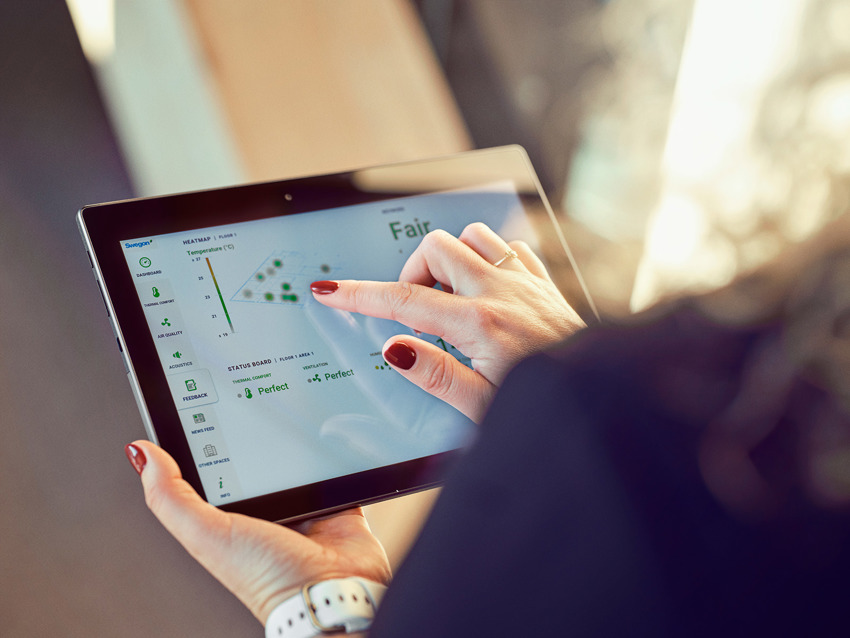Economic aspects
Most of what has been touched upon throughout this office guide has a connection to the economic aspects of a building. All phases, from design and construction to continuous use of a building, have an impact on building economics, direct or indirect. In this part of the guide investments and costs are put in relation to indoor climate and the value of people feeling good inside.
A review of factors that impact on building economics
Space-efficiency, energy-reduction and flexibility has so far been discussed in separate sections of this guide. To not mention an economic perspective in those contexts would have been unreasonable, but to not miss out, if entering the guide here, a short summary is found below.
Space-efficiency merely relates to chosen techniques and products for ensuring ventilation, heating and cooling without taking up space in the ceiling or loose valuable floor area. A spacious feel of the room can be economically valuable and most rents are based on square meters. Energy-reduction barely needs a further explaination but the key message is that energy-savings can be achieved with older, existing HVAC-solutions as well as with new. And, make sure to not chase any energy-save, compromising the indoor climate can be expensive. Last but not least, flexibility is a matter of ensuring a long-lasting building and indoor climate where both today's and tomorrow's tenants are happy to stay, and pay.
The people in the office are the most valuable
Building economics has so far been presented from a technical perspective, but there is the people aspect that is just as important to recognise. An office that succeeds to deliver a good indoor climate will also be an office where people are comfortable, can be productive and are happy to remain, both as employees and as tenants.
The above is proven in studies which states that people are 16% more productive when working in a good indoor climate, that the number of days of sick-leave are reduced thanks to a good indoor environment and that it is 30% more likely that an employee stays with a company that can offer a productive, healthy and comfortable office. Good air quality is certainly not the only criteria for a good indoor climate, low levels of particles and CO2 in the air have a substantial impact on how information is gathered and used. The below table show a 10% improvement in three typical real estate factors. It is evident that the productivity perspective has a remarkable impact on building economics.

It is 100 times more cost-effective to optimise the productivity of people working in the premises by offering an optimal indoor climate than saving energy. An optimal indoor climate holds large savings in the form of, e.g. reduced sickness absence costs.
Source: Jones Lang Lasalle, A surprising way to cut real estate costs www.us.jll.com (23 March 2022)
Installations and adjustments should be easy
Costs can be minimised by chosing products and systems where installation and commissioning, as well as later changes and adjustments, are made in a time-efficient and easy way.
As an example, Swegon WISE products connect wirelessly which significantly reduces installation time and eliminates the risk of misconnections. Products are digitally matched with the role they assume in the system and an automatic configuration is completed the first time the system is started. When system requirements change and adjustments are needed, the system configuration is altered digitally, very limited time by a technician is needed.
To get everything right from the beginning
The really expensive product or system choices are the ones that turn out to be incorrect or not allow for the good indoor climate that was initially required. To not end up in a situation where time-consuming product exchanges or compromises with a comfortable and productive indoor climate have to be made, product selection software and full-scale laboratory tests are ways foward.
Swegon ESBO has been mentioned before in this guide, it is a software tool used to ensure that an HVAC solution can ensure that requirements are met in terms of delivering a good indoor climate. In addition, product category specific softwares can save both time and money as product details and optimal operation is calculated during the selection phase. Examples of these software from Swegon are AHU Design, Room Unit Design and CH Design.
Get familiar with our software
Knowing more about the inside positively affects cost
Knowing the above, it is evident that it can be expensive to fail to deliver a good indoor climate. In addition, there are usually costs associated with customer complains as well as with long-standing product or system failures.
We have noticed that there is a greater acceptance for variations in the indoor climate if it is visualised and deviations are clearly communicated. More than 60% less complaints are noted with a better understanding of the the indoor climate and the parameters that has an impact thereof.
Further, costs are significantly reduced if an exacting maintenance plan is followed and issues are fixed shortly after their upcoming. To be able to view monitor and control an HVAC solution, and by the means of digital reports and notifications, be one step ahead of major problems or disruptions saves both time and money.
